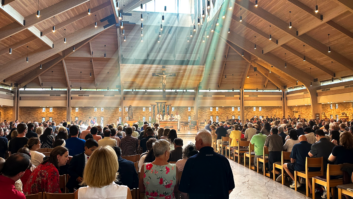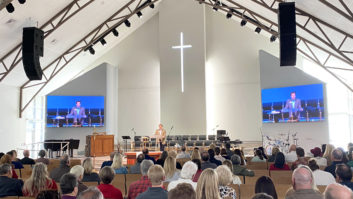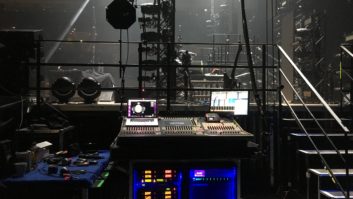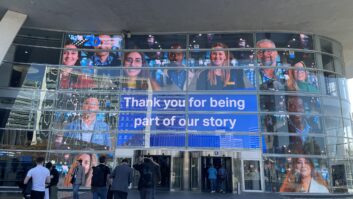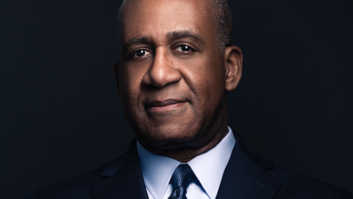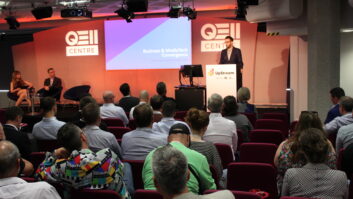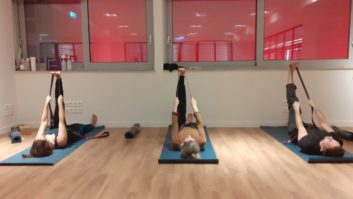In these uncertain economic times, it’s important to get some good news every now and then. In the field of audio conferencing, that good news is not hard to find, and the consensus is that the market is still growing – dramatically so in some instances.
Murat Keskinkilinc, product marketing manager conference systems at Bosch, says: “If we look at the past five years we see a continuous and healthy growth of our sales… People are becoming more aware of the advantages a conference system can offer, and they purchase a system to make their meetings more efficient, with functions like structured discussions and electronic voting.”
Finn Halken CEO of DIS (Danish Interpretation Systems), says: “It varies from sector to sector. At DIS the overall business is growing – and we see more interest in touch-screen conferencing as it is so flexible. No doubt more city councils want to have conferencing equipment – and the streaming/archiving of meetings has increased the market.”
Audio-Technica’s infrared-based ATCS-60 series was only introduced to the European market at the end of last year, although the manufacturer has been offering conferencing solutions in the Far East for some years.
Will Robertson, European areas sales manager at the company, says it’s difficult to see the immediate picture as adoption of the system is growing, while the bigger economic picture is recession.
“I have a sneaking suspicion that things will slow down over the next six months but they will start to increase as we move out of it,” Robertson offers. “The market where this system is aimed lags behind by six to 12 months.
“I think it’s a product that gets specified a lot in tenders and, obviously, the tender process takes some time. It’s not the same as a rental company having a show in the next two months and needing the equipment.”
Growing business
Juan Pablo Salvadores, export manager Middle and Far East at TLS Communication, also finds it hard to gauge any contraction in the market while the company is gaining new business. “Our efforts to conquer new markets in the Middle and Far East make us deal with enquiries from countries where we have never made business before,” he says. “While private business seems to be more sensitive to global uncertainty, government projects are still running in many markets. The situation is different in every market.”
His colleague Willi Rudy, export manager Russia, adds: “In Russia, demand is contracting because of the crisis and weakness of the rouble.”
Cory Schaeffer is co-owner and vice president of sales & marketing at Listen Technologies Corporation, which has been offering conferencing systems for more than five years. He says that demand is growing, with most regular business coming from smaller systems, rather than the more sporadic large projects.
“Growth is coming from the market really understanding these solutions and why they may be a better option than using traditional microphones, going back to a mic mixer, then distributing the audio through a sound system,” says Schaeffer. “Growth is coming from much smaller conferencing solution applications.”
Brett Downing, sales and marketing director at TOA Corporation in the UK, largely supports this view: “Demand is definitely growing because it’s more sensible and more cost-effective,” he says of TOA’s latest infrared system.
Matt Nettlefold is product manager, conference and presentations division, at Polaraudio, the UK distributor of products from beyerdynamic, Biamp and Dynacord, among others. “It seems to be growing,” he says of the market. “This year, we’ll have had our best March ever on conference systems. I know people are talking about the credit crunch but there is still a need for these systems because people want to spend less on flights between countries to have meetings.”
Alan March, business development specialist at Sennheiser UK, agrees the conference business is growing – especially for wireless. He adds that it’s “mainly driven by council chambers being hired out for multipurpose use when they are not being used for council meetings”.
New technology
So what are the latest developments on the technology front – and what are the user benefits?
Mark Child, director of product marketing at ClearOne, identifies the integration of wideband VoIP along with networking technologies as an area of significant development.
“By moving to VoIP, vendors can give conference participants a much better audio quality experience,” says Child. “And for the customer’s IT department, they benefit from having a common infrastructure that delivers better management and support of audio conferencing along with all communication technologies.
“Since VoIP is wideband and PSTN is narrow band, VoIP can deliver much better audio quality. This translates into conference calls that are more intelligible and with much less listener fatigue.”
Logan Helps, training and product support specialist for Audio-Technica in the UK, says: “The ATCS-60 is a third-generation product. “It’s the first time we’ve had the system in Europe and it’s good to know it has that much heritage.”
The ATCS-60 is fully automatic and makes extensive use of infrared. “With automated switching you often lose parts of words, but this system delays the signal so that the beginnings of words won’t be lost,” says Helps. The delay is only 50ms but it is enough for the system to open a mic channel slightly ahead of the speaker’s voice being amplified.
Other features include control software, so that video follows audio in videoconferencing applications. Audio recording is also integral and the system logs who is speaking so a written transcription can attribute quotes to the correct person.
“The market is changing, in that we used to see systems with a lot of gooseneck and boundary mics,” Helps observes. “But we see users moving more towards a single, simple package that meets all their needs.”
Child also notes the move towards integrated packages. “ClearOne products are able to integrate all of the standard conferencing technologies such as audio mixers, signal processors, and amplifiers,” he says. “In the installed audio conferencing market, this gives the end user a more robust product and gives the integrator an all-in-one solution.”
Nettlefold identifies digital wireless as “the key area in which there has been the biggest advance”. He also cites beyerdynamic’s Revoluto microphone technology as a significant move forward.
“This is where we’ve removed the goosenecks and gone with a line array principle instead,” Nettlefold explains. “It is totally unique in the conferencing market and it’s really starting to come into its own.
“The official word from Germany is that you would get the same output level at 80cm using a Revoluto microphone, as you would at 20cm away from a standard gooseneck microphone. Actually, we’ve found it to be somewhat better than that. Because of the way the Revoluto system works, people can stand up, sit down, move to the left or right – whatever they need to do – without a noticeable drop in the audio volume.”
Wireless draw
Keskinkilinc says Bosch has also seen the move to wireless: “Although fixed systems with extended functionalities still prefer our wired DCN next-generation conference system, there is a tendency towards wireless products in meetings. We see this especially in historic buildings where drilling is not allowed and cabling is a problem – and in multipurpose rooms where quick set-up and break-down times are required.”
He also notes an expansion in the capabilities of systems. “Next to the ‘traditional’ conference requirements, we see a growing niche market requiring a combination of a conference system and PC functionality. We have created the DCN Interactive solution.”
The system is touchscreen based. The main screen contains buttons for basic functions, such as mic activation, but further views can display voting results, a list of speakers, agenda, video, internet access, or other functions.
Halken sees touchscreens as a significant development for DIS as well as architectures offering “one system – indefinite number of languages”. This means that “conference systems turn visual as well as auditive”. “Now a participant can not only hear his own language, but he can see it as well.”
“The most significant development in conferencing from our point of view is the combination of different signal forms such as VGA, USB, audio, power and LAN, that can be transmitted,” says Ronald Behrmann, head of development, TLS.
Most manufacturers agree that there is still a market for wired systems but that the big growth is in wireless. March says: “Wireless conferencing is certainly seen as the way forward.” Sennheiser’s new WiCOS conference system utilises dynamic frequency management across two frequency ranges – 2.4GHz and 5GHz – and will automatically switch ranges if it detects interference.
Downing adds: “Wireless solutions are the most significant development, and with the introduction of infrared, installation has become much easier. Some companies actually put this into the dry hire for conferencing facilities, which is much easier on a wireless basis.”
Growth areas
So, the audio conferencing business is buoyant, with new technologies as well as new applications. But where specifically are the growth areas? Christine Sonnet, TLS’s export manager Europe, provides a succinct overview.
“In Europe, the sectors creating new business are: education, hotels, hospitals and local government,” she reveals. “The biggest markets for us in Europe are Scandinavia, Turkey, Switzerland and Benelux. Growth and success of a market are not only dependent on a country’s business situation but also on the quality of one’s partners and how intensively one is working on this market.”
Beyerdynamic senior product manager Ulrich Giehrl highlights some differences in demand between countries: “There are some regional -and cultural – differences across Europe,” he affirms. “In the Nordics and the UK/Netherlands, a general technical affinity can be observed. That is to say, voting functionality is preferred, compared with the middle/southern part of Europe [where a simpler solution is normally required].”
Differences in local authorities’ voting procedures also make for variations in requirements. For instance, voting in Germany is normally a secret process, whereas some countries require a record of the individual votes cast.
Giehrl adds: “In these times of financial crisis, the conference market is experiencing a slowdown to a certain degree.” However, there are factors counteracting this . In Germany, the government’s ‘Package of Measures’ means that approximately ?50 billion will be directed towards companies, private households and municipal authorities by next year. He also says that beyerdynamic is continuing to gain market share with competitive products such as the MCS 20 wired conference system.
Government growth
TOA’s Downing paints the picture in the UK: “Local government is an excellent and very strong market for TOA – 80% of our installations are in this market. Teleconferencing or videoconferencing is fast becoming less expensive than jumping on a plane.”
March agrees, and also cites translation as a growth area. Polaraudio’s Nettlefold adds: “Our key area for conference equipment has always been local government, where they’re addressing the Disability Discrimination Act [considerably extended in 2005] and replacing their old systems with new ones.”
Halken echoes the trend: “Right now our governmental business – both local and state – is growing due to the unique capabilities of our DIS systems.”
In many ways, the manufacturers and installers of conference systems seem to be in a win/win situation. When times are good, the corporate sector will invest in new systems to make its presentations glossier and more engaging. But in the current climate, companies are looking to reduce travel budgets by increasing their use of teleconferencing.
As for the public sector, it looks as if many European governments will maintain their spending as an instrument to keep the economy turning over.
